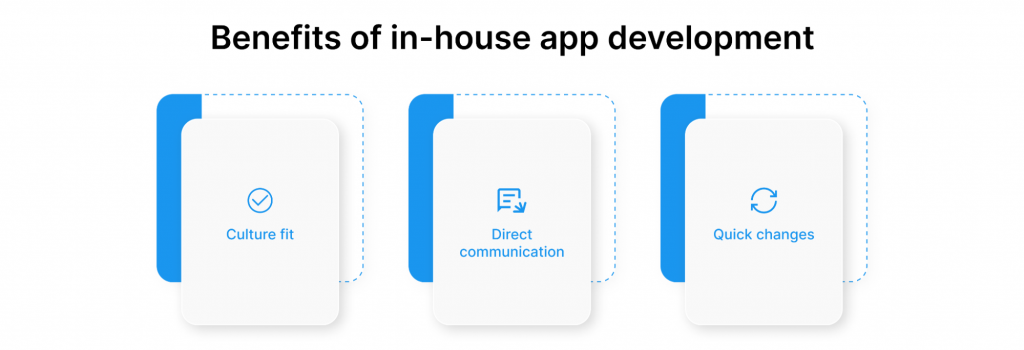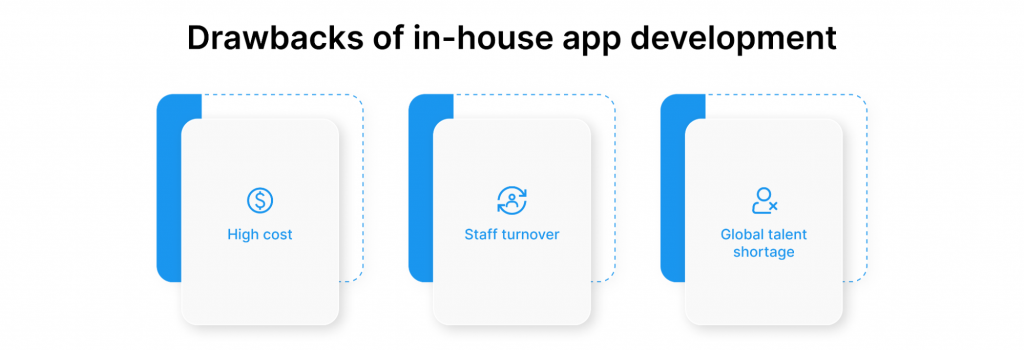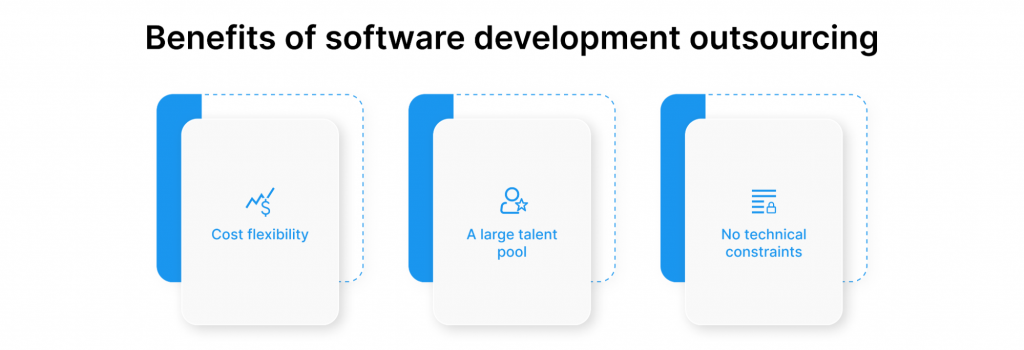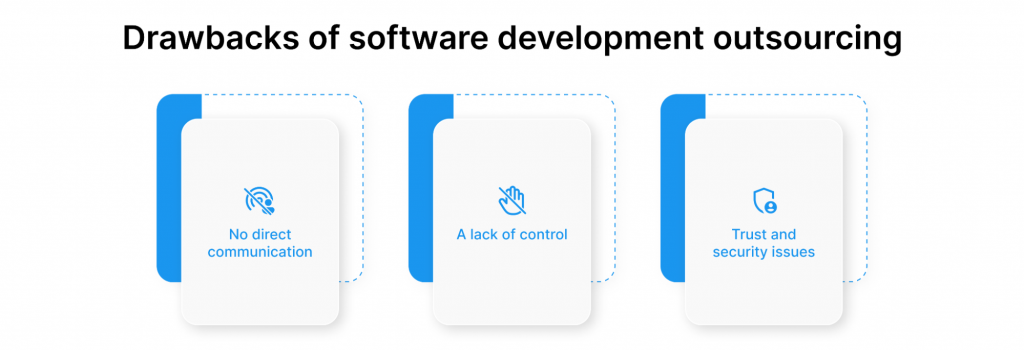In-house app development or outsourced app development is the not-so-easy question for tech startup founders and even multi-billion tech giants. That’s because there is no answer.
The right decision isn’t always clear since both approaches have their own pros and con and there are tons of variables that you need to consider. In today’s read, we compare in-house vs outsourcing to help you make the right decision for your business.
What is in-house software development?
In-house software development means building your own software development team from scratch and getting your app developed right in your office. You’ll be the one filling up the positions, onboarding new employees, and overseeing the whole development process. In-house development allows for total control of the project but at a much higher cost when compared to software development outsourcing.
Read also: How much does it cost to build an app?
In-house development is like hiring permanent staff for your company. You’ll need to go through all the hiring processes, from recruiting to onboarding. The cost of hiring a new employee is arguably one of the most expensive parts of running a company. You need to spend around $4,000 per hire, but the cost varies by role.
If your business isn’t focusing on an IT product, it may not be so viable to hire an in-house software development team. However, in-house software development can offer a lot of benefits.
Pros of in-house development
- Full culture match
Full-time employees pay much more attention to the specific needs and values of the company they are working for. They are more motivated to achieve better results and bring as much value as they can. It’s much easier for in-house employees to integrate with your company’s culture.
- Direct communication
Daily and face-to-face communication is a clear benefit luring to hire in-house software developers. Sharing the same working hours and being in one office make the communication process easier and more comfortable. Direct communication increases mutual understanding and effectiveness.
- Flexibility
When you have an in-house development team, it’s always faster to change app features, add new ones, and discuss technical issues. Also, in-house developers can fix all the bugs and iterate the product without delays.

Cons of in-house development
- High cost
While hiring in-house team members, be prepared to cover visible and hidden fees. According to Payscale, the average salary of a US-based software developer ranges up to $80k. That doesn’t include the hidden costs required to hire an in-house developer, including recruitment, onboarding, sick leaves, insurance, and vacation. When the team is idle between projects or tasks, you are to cover their fixed salaries.
- Turnovers
Recruiting the best talents to your team is easier than retaining them by fending off all the attempts by recruiters and competitors. In the end, you may counteroffer better benefits and ballon the payroll. Otherwise, you can lose your talents, and finding new developers is always time-consuming.
- Talent shortage
The rising demand for IT products brings a rising demand for skilled tech specialists. Hiring a new specialist meeting all the hard and soft skills can take months, so your development processes can be slowed down or stopped for quite a long period of time.

When to go for in-house development?
- In-house software development team
You already have a sufficient number of necessary specialists, or there is an opportunity to hire/train them in a short time. At the same time, you must be sure that the rest of the work of the employees won’t suffer from additional tasks. It is always better to entrust the project to genuinely reliable and competent specialists. It will save you from mistakes due to ignorance or lack of employee time.
- Material resources
You have the necessary material resources, or it will be profitable for you to buy or rent them. It can be machines, equipment, furniture, or workrooms. But even if the needed resources are available, alternative options for their use should also be calculated – rental, for example. It may turn out that it is more profitable to give the office space in rent and spend the profit on paying for the work of an outsourcing company. Acquiring the equipment and other resources can also be unprofitable if the project is short-term and the purchased equipment won’t be used after its completion. Also, you ‘shouldn’t spend money if the profit from the project doesn’t allow you to cover the additional costs. In this case, it is better to hire an outsourcing company with all the necessary equipment and office space.
- In-house project management
You have time to carry out the preparatory phase of the project: to draw up a detailed plan, to attract specific experts, recruit and train employees, and make sure that these people can comfortably interact with each other. Such preparation is necessary for a long-term task, a task that will be carried out throughout the company’s existence or for a long time. In this case, the formation of a new unit in the company’s structure for carrying out and managing such projects will be justified.
The specifics of the project suggest that people who are working on it are well aware of other work aspects of the company. Permanent employees are better than temporary workers. They are more motivated to get quality results for their company.
In all opposing situations, an in-house method can be costly and unjustified. Throwing all the forces at a short-term project raises risks in both relations – to the project itself and leading company activities. Competent specialists or material resources are distracted from the primary company duties, which makes the company weaker in general. It mainly works for small companies that haven’t enough resources to create new structural divisions for each new project. And any similar undertakings entail high financial and labor costs.
What is outsourcing software development?
Outsourcing means delegating the process of software development to a third-party provider. Nowadays, lots of companies choose to outsource software development processes to save time, cut costs, and find highly skilled IT professionals.
Software development outsourcing has been an ever-growing trend since its early days and its consistent growth hasn’t shown any signs of slowing down. It’s projected to reach $186.4 billion in revenue by 2028.
Read this article to find out how to outsource software development services in 2022.
Pros of software development outsourcing
- Cost flexibility
There are countries where premium talents cost much cheaper. Central and Eastern Europe, the Balkans, and Asia are the top regions to outsource software development services. Central Europe is becoming a central hub for software outsourcing due to highly qualified talents, low taxes, and government support of the IT sector.
To find the best country for software development outsourcing, check out this article.
- Broader talent pool
The widening of the talent pool helps you find the right talents for your project. When outsourcing, you aren’t limited to local candidates. Outsourcing provides you with unlimited opportunities. You can consider specialists from any part of the world and choose the best one.
- More technologies
Some projects require rare skill sets, and finding individuals or companies with all the skills and technologies required can be a real challenge. However, you can collaborate with a few software development companies that are proficient in different tools and technologies needed to bring your idea to life.

Cons of software development outsourcing
- No direct communication
Located in different countries, there are several things you need to take care of. A lot of people worry about the language barrier, but it has become a thing of the past. A vast majority of IT professionals have a nearly fluent command of English.
- A lack of control
While outsourcing, you have to direct access to the development team. You delegate all the development, progress, and troubleshooting to your outsourcing provider. But it doesn’t mean that you won’t know what’s happening with the projects.
With regular meetings, PMs will keep you notified about the progress of your project and any stumbling blocks. However, the vendor takes care of everything from recruitment to technical issues while you get more time and resources to focus on your core business tasks.
- Trust and security
You entrust confidential information to a third-party vendor. So you could feel underprotected and worried about the privacy policy of the agency. While signing an NDA, you can protect all your interests legally.

When is outsourcing for a large company better than an in-house software development team?
A notable argument in favor of turning to outsourcing companies for a large business is the ability of quick start and implementation of a specific project. It is often beneficial for large companies to outsource the initial stages of a project. After all, the selection of a team, searching for qualified managers, the organizing and integrating the working group by a small company is cheaper than by a huge business. Also, the necessary specialists help outsourcers carry out highly specialized tasks without delays.
Often the geographical factor is last but not least factor to consider. Contacting outsourcers in another country where the required services are cheaper is more profitable than recruiting staff in the native region.
The same applies to situations when you need to implement a particular project in another country. You need specialists with local knowledge who are physically located in that country and are ready to start work immediately. It is more justified to turn to outsourcers in such cases than to create a foreign branch, recruit new employees, and adapt to the local market.
Combine outsourced + in-house and get the best of both
Historically, choosing between outsourced and in-house development is quite challenging. But, you can hit the middle ground by combining outsourcing and in-house and get the best out of the two approaches.
You can assemble an in-house core team and outsource features that demand specific skills or technical expertise. Doing so allows getting access to a larger pool of tech talents while keeping control over key processes. Besides, you can save a pretty penny and have more flexibility in delegating resources.
In the field of software development, outsourcing is especially widespread. Almost any modern business needs its web or mobile application, the creation of which independently often doesn’t make sense.
IDAP works with all types of businesses and provides software application development services to cover all needs. We take on projects of any complexity and develop applications according to all customer requests. Drop us a line, and we’ll build a custom solution to power your business.
null



